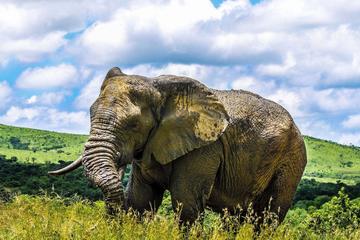
Top Historical Places And Monuments You Can Visit
by William Taylor
If you are passionate about history and about learning more about other countries’ heritage, your visit to Cape Town will offer you a lot of opportunities to explore the vibrant past of the city. You can either go on an organized tour or create your own itinerary to visit some of the exquisite historical buildings and museums of Cape Town.
The city itself is an open museum, with national parks, mountain tops and scenery that will you breathless. Table Mountain in particular, is Cape Town’s “watcher”. The view of the bustling metropolis is outstanding from the top. As for historical places, avid travelers might want to cross off the following from the list:
1. South African Museum
A good place to start is the South African Museum, which focuses on the anthropological, geological and marine life of the continent. Their collection includes thousands of objects, some of them dating 120.000 years back. You will be able to admire fascinating rock art and stone tools, traditional costumes from centuries ago and objects from the everyday life of the people living here thousands of years ago. The museum also holds animal specimens, like 700-million years insect fossils, whale skeletons and depictions of dinosaurs that once inhabited the South African plains.
2. Bo Kaap
You will be mesmerized at the sight of this neighborhood in Cape Town, as all the houses are brightly colored in contrasting shades of yellow, fuchsia, green, blue and many more, making this area a breathtaking sight and wonderful destination. The romantic cobbled stone streets date back to the 18thcentury, making Bo Kaap one of the oldest residential areas in the South African city. The residents of Bo Kaap are the descendants of slaves that were brought here by the Dutch; after their emancipation in 1795, they formed this community and settled in this incredible place of amazing historical meaning.
3. Castle of Good Hope
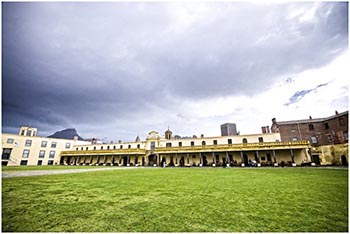 Not only a destination for the history buffs, Castle of Good Hope is a top historical site to explore when visiting Cape Town. This is the oldest surviving building in South Africa and after its restoration in the ‘80s it is considered one of the best preserved examples of DEIC (Dutch East India Company) architecture in the world. Not only the Castle of Good Hope provides an insight on the country’s colonial past, it also hosts numerous art and photography exhibitions for the tourists and locals, being an active cultural site.
Not only a destination for the history buffs, Castle of Good Hope is a top historical site to explore when visiting Cape Town. This is the oldest surviving building in South Africa and after its restoration in the ‘80s it is considered one of the best preserved examples of DEIC (Dutch East India Company) architecture in the world. Not only the Castle of Good Hope provides an insight on the country’s colonial past, it also hosts numerous art and photography exhibitions for the tourists and locals, being an active cultural site.
4. District Six Museum
District Six is a former residential area of Cape Town that used to be a lively community of former slaves of all ethnicities and races. In 1966, during the apartheid era, the district was declared a whites-only area and more than 60,000 of its inhabitants were forcibly removed, on the counts that it is a crime ridden district that has no chance of improvement. In 1994 the District Six museum came into being, as a reminder of the lively community that once thrived here. The museum has a map of the district depicted on its floor and several formal residents had written notes on the places where they used to live. It’s an emotional experience and it will teach you more the struggling past of this wonderful country.

 5. Houses of Parliament
5. Houses of Parliament
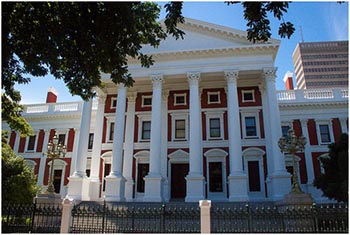 This impressive historic building has been the seat of the National Parliament since 1910 and it opens its gates for tourists each year when the Parliament is in session (first part of the year). Be sure to book a visit in advance if you’re traveling from another country and get informed about any closed doors events. You can admire over 4,000 artworks collected by the gallery of the House of Parliament and enjoy a walk around the premises. The guided tours are free of charge and you can also book tours for groups of up to 25 people.
This impressive historic building has been the seat of the National Parliament since 1910 and it opens its gates for tourists each year when the Parliament is in session (first part of the year). Be sure to book a visit in advance if you’re traveling from another country and get informed about any closed doors events. You can admire over 4,000 artworks collected by the gallery of the House of Parliament and enjoy a walk around the premises. The guided tours are free of charge and you can also book tours for groups of up to 25 people.
If You Go:
Cape Town is outstanding from all points of view. There are lots of other monuments, museums and places of interest travelers can visit. Most of them reveal valuable information about South Africa’s culture, customs and traditions. Make sure to check out the ones above, and you’ll learn to value the places and the people of the city even more.
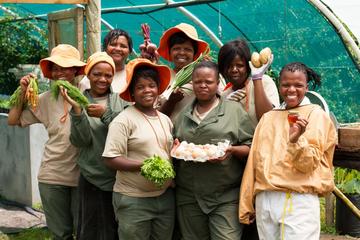
Cape Town City Tour: Culture and Community Projects
About the author:
William Taylor is a traveling freak who has traveled many destinations around the world. He also loves writing about his traveling experiences and the places he has explored.
All photos by William Taylor


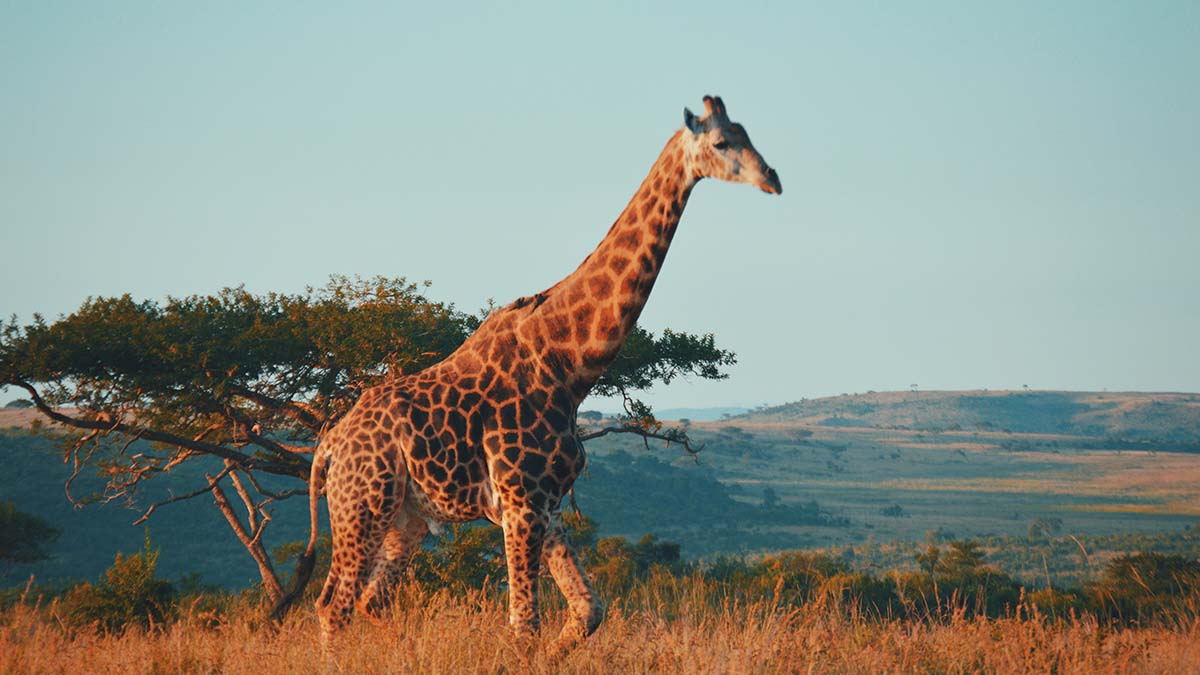
 As you fly into Johannesburg you would expect to see the wild game from the runway. Close to the tarmac is a beautiful view of elephant grass (tall grasses) and native trees that bring memories of photos depicting Africa or the Lion King. I travelled there in August which would be the southern hemisphere winter. Well, if that is winter, it sure does not resemble the Canadian winters. Each day, whether in Johannesburg, Pretoria, Durban, or Capetown all provided an average temperature between 26 to 29C each day and sunshine over my three week adventure. South Africa winter certainly is quite manageable.
As you fly into Johannesburg you would expect to see the wild game from the runway. Close to the tarmac is a beautiful view of elephant grass (tall grasses) and native trees that bring memories of photos depicting Africa or the Lion King. I travelled there in August which would be the southern hemisphere winter. Well, if that is winter, it sure does not resemble the Canadian winters. Each day, whether in Johannesburg, Pretoria, Durban, or Capetown all provided an average temperature between 26 to 29C each day and sunshine over my three week adventure. South Africa winter certainly is quite manageable.
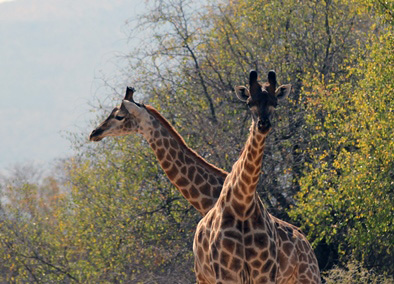 My first experience in SA was a 1.5 hr drive to Sun City. If you have watched the movie Blended you will have seen one of the hotels as the movie was filmed at Sun City Palace and the complex. There are four hotels on the premises ranging up to $8000 per night. Something for everyone, Players golf course, a children’s arcade, spa, casino, and high tea at 3 pm is highly recommended to see the Sun Palace hotel as that is the only access to this posh hotel.
My first experience in SA was a 1.5 hr drive to Sun City. If you have watched the movie Blended you will have seen one of the hotels as the movie was filmed at Sun City Palace and the complex. There are four hotels on the premises ranging up to $8000 per night. Something for everyone, Players golf course, a children’s arcade, spa, casino, and high tea at 3 pm is highly recommended to see the Sun Palace hotel as that is the only access to this posh hotel.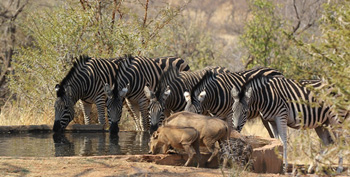 Food is also a bargain either at the grocery store or at the restaurants. Kentucky Fried Chicken appeared to be the most popular fast food to be found in SA with Macdonald’s a close second. KFC signage is atop the illuminated street names and almost on every street corner similar to Starbucks can be found in Canada. Both KFC and MacDonald’s offer free scooter delivery service for orders. Other restaurants offer bountiful breakfasts that can be found for around $3. Restaurants are also inexpensive offering lunch specials ranging from R57 ($5.70 CDN) which includes a salad and portions that are monstrous. Bottles of wine can start at R110 and up in a restaurant and beer at R25. Evening dinner options can be a full chicken and salad for R90. That would be a feast for a big appetite or a feast and a take home feast for the lighter appetites. Don’t worry if you don’t finish that bottle of wine. You can take it home. Most places appear to be children friendly with play areas and some even have child attendants. Some restaurants offer a complete experience for children to order their own pizza and help the chef make their pizza. Children put on their own toppings while the parents can enjoy a leisurely lunch or dinner.
Food is also a bargain either at the grocery store or at the restaurants. Kentucky Fried Chicken appeared to be the most popular fast food to be found in SA with Macdonald’s a close second. KFC signage is atop the illuminated street names and almost on every street corner similar to Starbucks can be found in Canada. Both KFC and MacDonald’s offer free scooter delivery service for orders. Other restaurants offer bountiful breakfasts that can be found for around $3. Restaurants are also inexpensive offering lunch specials ranging from R57 ($5.70 CDN) which includes a salad and portions that are monstrous. Bottles of wine can start at R110 and up in a restaurant and beer at R25. Evening dinner options can be a full chicken and salad for R90. That would be a feast for a big appetite or a feast and a take home feast for the lighter appetites. Don’t worry if you don’t finish that bottle of wine. You can take it home. Most places appear to be children friendly with play areas and some even have child attendants. Some restaurants offer a complete experience for children to order their own pizza and help the chef make their pizza. Children put on their own toppings while the parents can enjoy a leisurely lunch or dinner. Driving is an experience. Although sidewalks are a rare finding, the large dirt sections next to the road offer opportunities for vendors to set up business and cars can pull off the road to shop; SA people are very enterprising. On most traffic lighted city street corners, men can be found wandering between the lanes selling most anything: Newspapers, toys, pens, crafts, computer gadgets, but I did not see a kitchen sink. Companies and businesses also hire people to advertise at the street light corners to hand out pamphlets. It is always recommended, no matter where you may be in the world, to travel and drive with your doors locked. As anywhere, there are places that you should not venture for safety reasons. Having said that, I did not experience any adverse experiences. In SA taxi services are communal for the locals. Specific hand gestures indicate where you want to travel as the taxi vans travel the streets. People are packed 4 across and 5 deep holding over 20 people per taxi van.
Driving is an experience. Although sidewalks are a rare finding, the large dirt sections next to the road offer opportunities for vendors to set up business and cars can pull off the road to shop; SA people are very enterprising. On most traffic lighted city street corners, men can be found wandering between the lanes selling most anything: Newspapers, toys, pens, crafts, computer gadgets, but I did not see a kitchen sink. Companies and businesses also hire people to advertise at the street light corners to hand out pamphlets. It is always recommended, no matter where you may be in the world, to travel and drive with your doors locked. As anywhere, there are places that you should not venture for safety reasons. Having said that, I did not experience any adverse experiences. In SA taxi services are communal for the locals. Specific hand gestures indicate where you want to travel as the taxi vans travel the streets. People are packed 4 across and 5 deep holding over 20 people per taxi van.
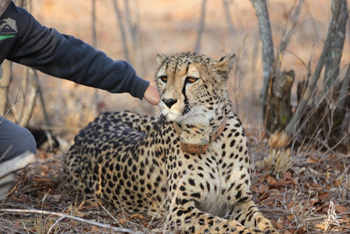 Mabalingwe was my first experience in a wild game reserve. This is under two hours from Pretoria. Your first view of a kudu, impala or warthog is exhilarating and you can’t get your camera poised fast enough. After a while the appetite for photographing new wild game gets more and more intriguing. The first 24 hours I had sited and photographed 14 different wild African animals in their natural environment. This included the ostrich, impala, kudu, baboon, warthog, bandit mongoose, giraffe, zebra, hippopotamus, crocodile, hyrax, duiker, hyala, and jackal. Patience is a virtue and wild animals do not pose or come out from behind the brushes. They do, however, need water and that is a good place to see many different animals. The best time of the day to find animals is the early morning and closer to the end of the day. Even in winter, midday is too warm for the animals and they siesta until closer to the end of day. Our morning safari were as early as 6 am and the sunset safari started at 3 pm as it becomes dark around 6 pm.
Mabalingwe was my first experience in a wild game reserve. This is under two hours from Pretoria. Your first view of a kudu, impala or warthog is exhilarating and you can’t get your camera poised fast enough. After a while the appetite for photographing new wild game gets more and more intriguing. The first 24 hours I had sited and photographed 14 different wild African animals in their natural environment. This included the ostrich, impala, kudu, baboon, warthog, bandit mongoose, giraffe, zebra, hippopotamus, crocodile, hyrax, duiker, hyala, and jackal. Patience is a virtue and wild animals do not pose or come out from behind the brushes. They do, however, need water and that is a good place to see many different animals. The best time of the day to find animals is the early morning and closer to the end of the day. Even in winter, midday is too warm for the animals and they siesta until closer to the end of day. Our morning safari were as early as 6 am and the sunset safari started at 3 pm as it becomes dark around 6 pm.


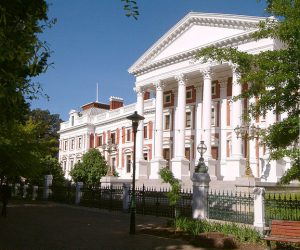
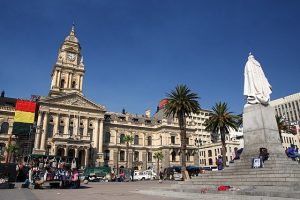


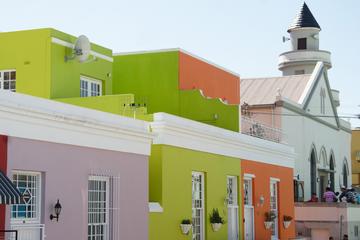
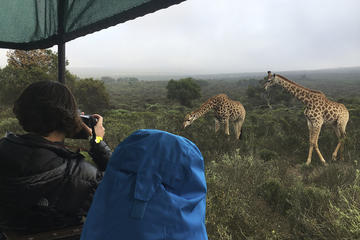
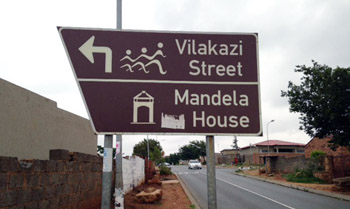
 The project was overseen by the South Africa Development Agency. “The community is very happy with the result,” says Thanduxolo Ntoyi, an assistant development manager at the agency. The community was “very involved” with the street and its transformation from the beginning.
The project was overseen by the South Africa Development Agency. “The community is very happy with the result,” says Thanduxolo Ntoyi, an assistant development manager at the agency. The community was “very involved” with the street and its transformation from the beginning.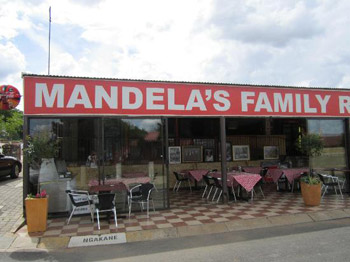 Outside the house stands a large metal outline of two bull heads, entitled The Nobel Laureates. The title refers to the fact that on the corner of Vilakazi and Ngakane Streets, a short distance away, is the Soweto home of the Anglican Archbishop Emeritus Desmond Tutu, who, like Mandela, was the recipient of a Nobel Peace Prize. The bulls look down the road, decisive and eye-catching, leaving no doubt as to the strength of the two personalities they represent. Around the corner in Moema Street is another metal depiction, this time of schoolchildren facing a policeman with a growling dog. It’s a reference to the confrontation on 16 June 1976 when hundreds of black school children were protesting the imposition of European Afrikaans in schools, when they were met by the brutality of the colonial police.
Outside the house stands a large metal outline of two bull heads, entitled The Nobel Laureates. The title refers to the fact that on the corner of Vilakazi and Ngakane Streets, a short distance away, is the Soweto home of the Anglican Archbishop Emeritus Desmond Tutu, who, like Mandela, was the recipient of a Nobel Peace Prize. The bulls look down the road, decisive and eye-catching, leaving no doubt as to the strength of the two personalities they represent. Around the corner in Moema Street is another metal depiction, this time of schoolchildren facing a policeman with a growling dog. It’s a reference to the confrontation on 16 June 1976 when hundreds of black school children were protesting the imposition of European Afrikaans in schools, when they were met by the brutality of the colonial police.
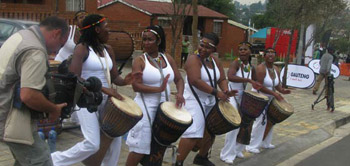 At the start of Vilakazi Street, where it intersects with Khumalo Street, is another magnificent artwork. Eight huge, grey hands spell “Vilakazi” in sign language. The hands are big and bold, but accessible to residents – they have become play objects, with children taking time out to climb on them. Other art includes two murals – one depicts the scene of June 1976, with police and their vans, and placard-carrying schoolchildren. And then there are the mosaics, livening up several concrete benches on the corner of Moema Street; down Vilakazi Street are mosaic strips of paving. On the corner of Vilakazi and Ngakane streets is a row of bollards with decorative wooden heads. Vilakazi Street is indeed a different place.
At the start of Vilakazi Street, where it intersects with Khumalo Street, is another magnificent artwork. Eight huge, grey hands spell “Vilakazi” in sign language. The hands are big and bold, but accessible to residents – they have become play objects, with children taking time out to climb on them. Other art includes two murals – one depicts the scene of June 1976, with police and their vans, and placard-carrying schoolchildren. And then there are the mosaics, livening up several concrete benches on the corner of Moema Street; down Vilakazi Street are mosaic strips of paving. On the corner of Vilakazi and Ngakane streets is a row of bollards with decorative wooden heads. Vilakazi Street is indeed a different place.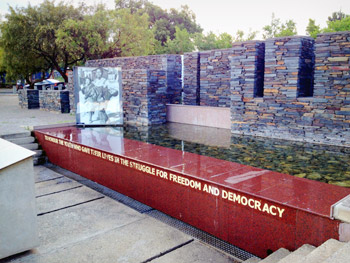 This is another landmark that enriches Vilakazi Street. This memorial has been completed, and it remembers the 15-year-old boy who was the first to be shot on 16 June 1976 riots against the white apartheid government. On the corner of Klipspruit Valley and Khumalo roads is a bridge where Hastings Ndlovu was shot by the police. He was rushed to Chris Hani Baragwanath Hospital – one of the world’s biggest hospitals- where he died of the head wound.
This is another landmark that enriches Vilakazi Street. This memorial has been completed, and it remembers the 15-year-old boy who was the first to be shot on 16 June 1976 riots against the white apartheid government. On the corner of Klipspruit Valley and Khumalo roads is a bridge where Hastings Ndlovu was shot by the police. He was rushed to Chris Hani Baragwanath Hospital – one of the world’s biggest hospitals- where he died of the head wound.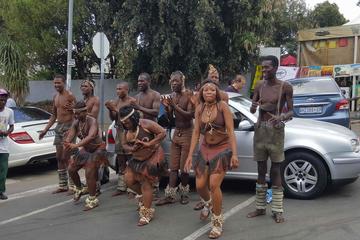

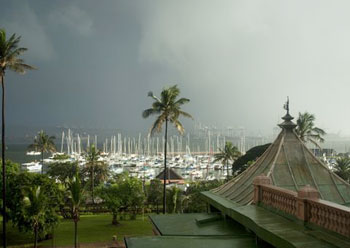
 Durban throbs with the rhythms of Black Africa that are not as accessible on the typical tourist track. The aromas wafting from stalls and cafés are unidentifiable, but worth exploring. Street vendors sell everything from beadwork to biltong (spicy, dried meat). The African taxis, actually ten-passenger vans, clog the city streets hawking for business and owning the road. Women carry grocery bags on their heads and kids on their backs. It’s high energy here and crowded.
Durban throbs with the rhythms of Black Africa that are not as accessible on the typical tourist track. The aromas wafting from stalls and cafés are unidentifiable, but worth exploring. Street vendors sell everything from beadwork to biltong (spicy, dried meat). The African taxis, actually ten-passenger vans, clog the city streets hawking for business and owning the road. Women carry grocery bags on their heads and kids on their backs. It’s high energy here and crowded.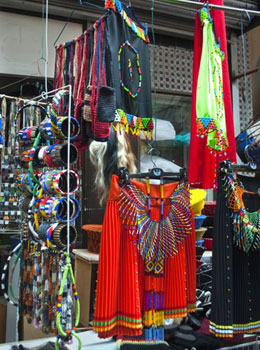 On day three, I take a city tour recommended by locals. Richard Powell and his Zulu assistant, Sthembiso, of Street Scene Tours treat me to a five-hour tour that costs under $40.00 including lunch. This is not your average tour, but an experience that exposes the beat of African Durban. The pair work as a tag team: Richard explains the city’s layout and history as we pass the colonial landmarks, and Sthembiso describes the African outlook and way of life as we meander through the Zulu markets and Muslim arcades.
On day three, I take a city tour recommended by locals. Richard Powell and his Zulu assistant, Sthembiso, of Street Scene Tours treat me to a five-hour tour that costs under $40.00 including lunch. This is not your average tour, but an experience that exposes the beat of African Durban. The pair work as a tag team: Richard explains the city’s layout and history as we pass the colonial landmarks, and Sthembiso describes the African outlook and way of life as we meander through the Zulu markets and Muslim arcades. Since Durban was settled, the large East Indian population has offered its traditional dishes all over the city. Their most famous is Bunny Chow. The Indians who caddied at the Royal Durban Golf Club never had time to stop for lunch, so Mr. Bunny created a unique curry sandwich they could munch on the go. He scooped out the centre of half a loaf, filled the hole with a spicy curry, and stuffed the bread back on top. I eat mine with my fingers, mopping up the hot sauce with pieces of bread and loving it.
Since Durban was settled, the large East Indian population has offered its traditional dishes all over the city. Their most famous is Bunny Chow. The Indians who caddied at the Royal Durban Golf Club never had time to stop for lunch, so Mr. Bunny created a unique curry sandwich they could munch on the go. He scooped out the centre of half a loaf, filled the hole with a spicy curry, and stuffed the bread back on top. I eat mine with my fingers, mopping up the hot sauce with pieces of bread and loving it.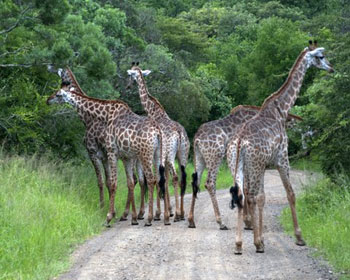 The thatched Hilltop Lodge overlooks a wide valley and is blessed with all the amenities of an excellent hotel, including delicious breakfast and dinner buffets. As I push open the door of our roomy cottage, my first sight is a warning about marauding baboons – the robust grills over our windows speak volumes. Harmless Vervet monkeys gambol all around us.
The thatched Hilltop Lodge overlooks a wide valley and is blessed with all the amenities of an excellent hotel, including delicious breakfast and dinner buffets. As I push open the door of our roomy cottage, my first sight is a warning about marauding baboons – the robust grills over our windows speak volumes. Harmless Vervet monkeys gambol all around us.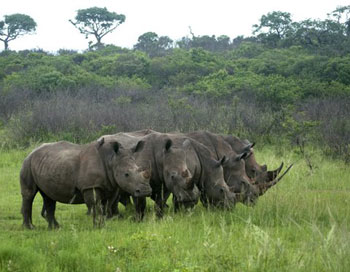 Abruptly the park ranger stops and points out a couple of Nyala (antelope) on a distant slope. Even with binoculars I can barely see them – is this as close as we will get to the game? Then over the next rise, a Black Rhino grazes not 50 feet away. We turn another corner and nearly run into a giraffe. After that, the game appears thick, fast, and close until the sun sets. But the best comes after dark, when we disturb a lion lying in the middle of the trail. He hightails into the bush but stops ten feet away and, with the aid of a spotlight, I can count his teeth when he yawns.
Abruptly the park ranger stops and points out a couple of Nyala (antelope) on a distant slope. Even with binoculars I can barely see them – is this as close as we will get to the game? Then over the next rise, a Black Rhino grazes not 50 feet away. We turn another corner and nearly run into a giraffe. After that, the game appears thick, fast, and close until the sun sets. But the best comes after dark, when we disturb a lion lying in the middle of the trail. He hightails into the bush but stops ten feet away and, with the aid of a spotlight, I can count his teeth when he yawns.